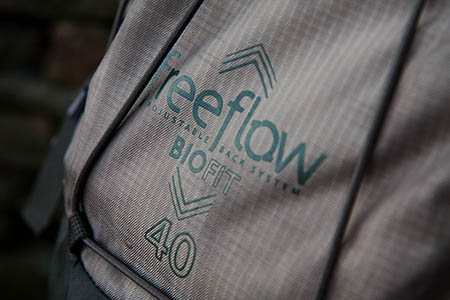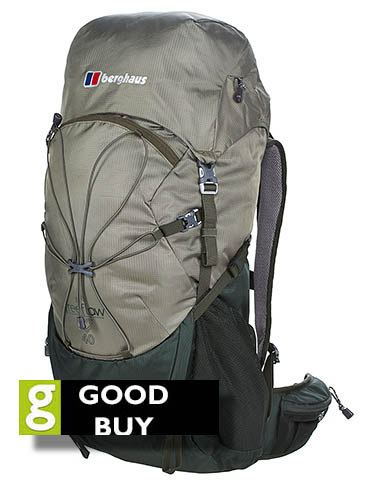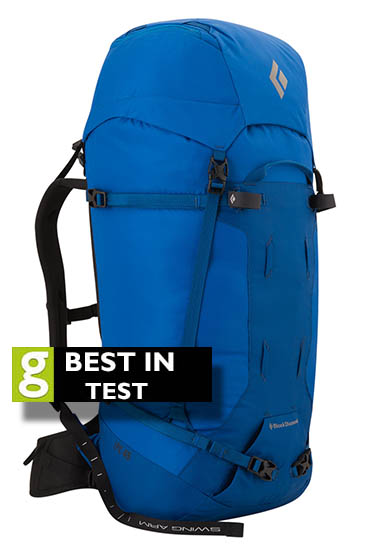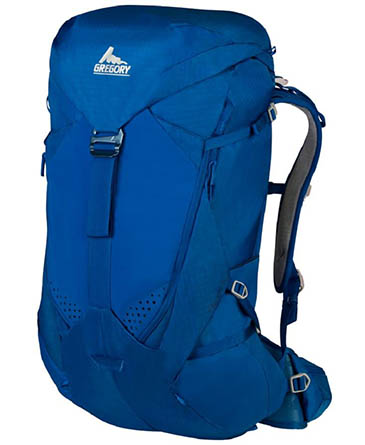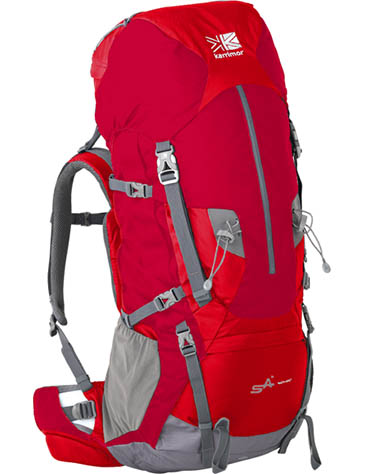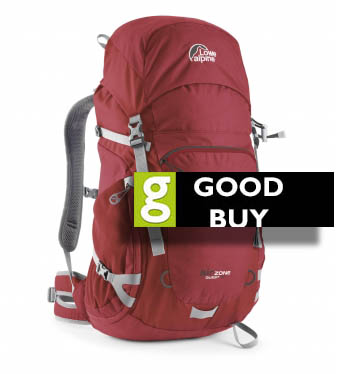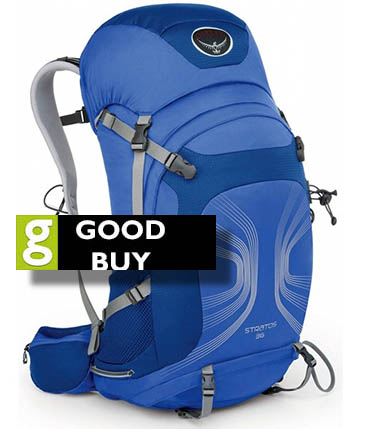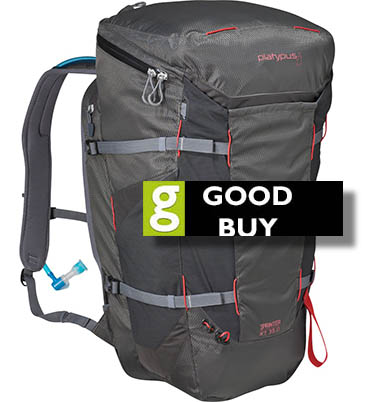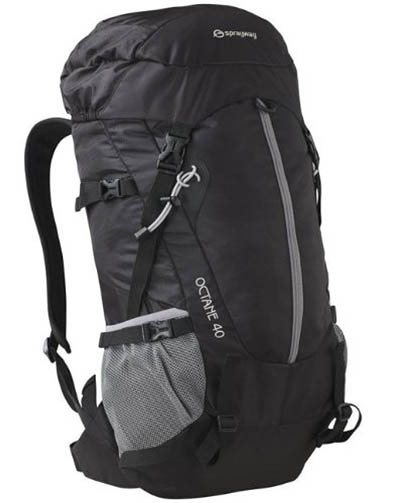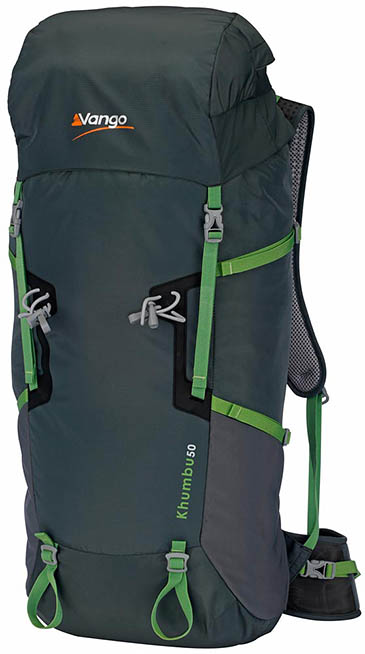A good, comfortable rucksack can make your day in the hills much more pleasurable, whereas a badly fitting or poorly designed one can cause a lot of grief.
These large daypacks were chosen as suitable for a winter’s day on the mountains where you need the extra space for items such as crampons and extra clothing; alternatively, they are all big enough – some of them just – to take all the gear needed for a two-day expedition with an overnight camp.
We asked the brands to supply us with rucksacks with a rated capacity of between 30 and 55 litres.
Our test load included a one-person tent; stove and pans; sleeping bag; inflatable sleep mat; small first-aid kit; waterproofs; insulated jacket; extra mid-layer; hat; gloves; hydration reservoir and tube, plus our bag of odds and ends that goes everywhere with us, which has a headtorch, GPS unit, compasses, whistle, writing pad, pen and emergency energy cubes.
You’ll need to pack food too on either a day trip or backpacking outing.
We also attached a pair of walking poles to the packs.
Our load, including the rucksacks themselves, tipped the scales at about 13kg (29lbs).
Berghaus Freeflow II 40
Country of manufacture: Vietnam
Weight: 1,382g
Price: £90
Colour: green/dark green
Rated capacity: 40 litres
Berghaus has updated its popular Freeflow range for spring 2014. The 40-litre capacity Freeflow II 40 now has a narrowed gap between the pack’s rear panel and the suspension system that keeps it away from the body.
Berghaus said the air gap still allows ventilation of the user’s back but improves packability. Some models with pronounced curvature of the back panel to provide air flow suffered from an intrusion into the rucksack’s internal space, but this is now minimised on the II series’ biggest pack.
The Freeflow II 40 also has the company’s Biofit system, which allows the user very simply to select a back size between XS and XL in infinitely variable steps, by pulling on a strap attached to the harness system, which can be done even while wearing the pack.
Berghaus has also remodelled its pre-moulded frame to improve overall comfort.
The main compartment is accessed from a wide top opening, with drawcord fastening which sits under the lid when in use. There is an elasticated pouch for a hydration bladder, with a tube exit to the right shoulder and a single elasticated loop on the right shoulder strap.
There is also a lower compartment with a separate external zip opening for access. The lower compartment has an internal zip which enables it to be opened up to the main compartment, making one large single space if preferred.
Another external zipped pocket sits on the front of the pack, with a shockcord bungee system that both allows for attachment of extra gear and also forms part of the volume adjustment system, though in practice we found it a little fiddly to use.
There are two large mesh outer pockets, big enough to take a large drinking bottle or even a laminated OS map. There are two ice-axe loops which can also be used for walking poles and a clipped strap on each side of the main body of the pack to hold them.
The lid has a fair-sized main compartment, zipped at the back and with a key clip and underneath is a zipped document compartment.
On the right-hand hip belt it a zipped mesh pocket, handy for things such as a compass.
The Freeflow system does cut down on build-up of perspiration in the back area, and its revised shape allows a more accommodating main compartment. There’s ventilation on the shoulder straps too.
In use, the pack was comfortable. Although there isn’t much in the way of padding on the shoulder harness, it still felt OK out on the hill. The hipbelt has more foam and worked very well, supporting the rucksack.
The small plastic hipbelt buckle was a bit fiddly to use when wearing gloves, as were the adjusters.
The Freeflow II 40 coped with our overnight kit, with a little space to spare and worked well on the hill.
Pros:
Back ventilation
Easy back-length adjustment
Cons:
Fiddly buckles
Performance 31/35
Comfort 31/35
Features 7/10
Quality 7/10
Value for money 7/10
Total score: 83/100
Black Diamond Epic 45
Country of manufacture: Philippines
Weight: 1,564g
Price: £129
Colour: blue
Rated capacity: 40 litres
The Epic 45 has clearly been designed with Alpinists in mind: its simple, large main compartment swallows up a good amount of gear and there are no extra external pockets to snag on rocks.
The pack takes a lot of gear without difficulty and can be extended upwards with its ‘skirt’ and floating lid to accommodate even more tackle if needed.
On the front of the pack is a reinforced section against which crampons can be attached using a pair of straps provided.
A pair of ice-axes or walking poles can be attached to the outside of the pack using the Black Diamond ‘Pick Pockets’.
Inside the main compartment is an elasticated pouch for a hydration system and the exit aperture for a tube is central, which means it can be routed then to either the left or right shoulder strap.
At the top of the main compartment is a rope strap which can be used to secure a rope across the top of the pack. The pack’s lid, zipped at the back, also has helmet attachment loops.
The padded hip belt has loops for climbing gear.
The shoulder straps, back and hip belt all have solid foam padding and there is a cut-out channel up the back to help ventilation.
It’s the Epic 45’s harness system that marks it out. The hip belt has ergoACTIV suspension, which rotates a few degrees as the hips move, meaning that as you scramble over rocky sections, the pack itself stays largely upright, helping balance.
Allied with this is the SwingArm shoulder strap system which also allows the arms to reach high without destabilising the pack.
In practice, this means the rucksack doesn’t move around much even though you are. The increase in stability is useful when in situations where balance is crucial.
There are no pockets on the hip belt, gear loops instead taking their place.
The channel in the back foam does help ventilate a little, though not as much as some of the more ‘suspended’ back systems.
We thought the rotating section of the hip system might feel a little intrusive but it has a generous foam area and, though we were aware of it while walking, it did not feel uncomfortable.
In a way, the Epic 45 is the simplest of rucksacks: apart from the generous lid pocket, it has only the one compartment. No side pockets; no front pocket; no other snagging features.
But it’s also one of the best designed, with lots of useful touches. The harness system is comfortable and gives confidence over difficult terrain. The floating lid is useful if you need to accommodate a bit of extra gear, though the pack feels more generous than its rated 45 litres anyway.
The rucksack feels sturdy and quality is good. The Epic 45 just feels like a serious piece of mountaineering kit that means business.
Pros:
Good capacity
Simplicity
Cons:
Price
Performance 33/35
Comfort 31/35
Features 7/10
Quality 9/10
Value for money 6/10
Total score: 86/100
Gregory Miwok 44 med
Country of manufacture: not stated
Weight: 1,312g
Price: £115
Colour: blue
Rated capacity: 44 litres
The Miwok 44 has one large main compartment, accessed either through the top opening protected by a drawcord and the lid or via a zip round the extra pouch on the front of the pack.
This is a stretchy, ventilated large outer pocket for storing extra gear and it also contains the pack’s raincover within a separately zipped compartment.
The lid has a largish main compartment with key loop and underneath a separate zipped document compartment. The whole lid is secured down by an unusual arrangement. Instead of the usual plastic clip, a metal hook on an adjustable strap slides through a fabric loop on the front of the lid. We found this a bit more fiddly on the hill than a conventional plastic buckle.
There are two large side pockets with stretch panels, both easily big enough to take a folded OS map or a sizeable drinks bottle.
The pouch for a hydration bladder is accessed from outside the main compartment, though the lid still has to be opened. However, the main compartment can be left pulled closed by its drawcord while refilling a water reservoir. The tube exit is central and there is a tube clip on the right-hand shoulder strap.
There are top and bottom compression straps for the main body of the pack, and there are also two loops for walking poles or ice-axes.
On the hip belts are two small zipped pouches, big enough for, for instance a compass or GPS unit.
The hip belts, like the shoulder straps, are heavily ventilated, with a mesh overlaying foam with lots of holes to help perspiration get out.
The back of the pack is similar, with mesh and foam sandwiched between the wishbone struts that narrow towards the small of the back.
The Miwok 44 easily took our kit, with space to spare and that was without using the lid or front pocket.
Despite sitting close to the back, the pack actually ventilated quite well and perspiration was well under control.
We found it quite difficult to get the tension right on the hip-belt so that it bore most of the weight. The hip sections are wide and padded but the centre section is a thinnish strap that, if tightened too much, cut into the abdomen.
The two walking pole bungees work very well and were among the easiest on test to use. The bottom loops, which can also be used for ice axes, tuck away when not in use.
The pack felt tough and the compression system worked well.
Pros:
Good capacity
Pole/ice-axe attachment system
Cons:
Thin waist belt
Performance 31/35
Comfort 29/35
Features 8/10
Quality 8/10
Value for money 6/10
Total score: 82/100
Karrimor Cougar 40 50
Country of manufacture: China
Weight: 2,026g
Price: £139.99/£48
Colour: red/grey
Rated capacity: 50 litres
The Cougar feels like a big pack. We managed to fit both our sleeping bag and stove and pans into the bottom compartment, which has a separate opening.
The main compartment swallowed the rest of our overnight expedition gear, including tent and inflatable mat, plus clothing, first-aid kit and the rest of the necessities for a trip to the hills.
If you prefer, you can open up the bottom storage area with the main compartment by use of an internal zip.
There is also a separate, zipped front compartment and two zipped side compartments. The main area of the pack can also be accessed via an external zip without unfastening the lid.
The Cougar also has twin outside stretch mesh pockets for items such as drinks bottles.
For those who prefer a hydration reservoir, the pack has a pouch within its main compartment, with a tube exit leading to the right shoulder strap.
The main compartment closes by means of a ‘skirt’ with drawcord, supplemented by a compression strap with clip.
The lid compartment is large, with a zip to the rear. There is also a separate zipped mesh document section under the lid. In case there isn’t quite room for all your gear inside the various pockets, the lid also has a bungee set-up to attach extra gear.
The pack has ice-axe loops and can also walking pole loops which worked well.
The main compartment has top and bottom compression straps to adjust the volume.
The harness features Karrimor’s SA2 adjustment system. This allows the shoulder straps to be slid up or down the pack’s two aluminium frame struts to achieve the required back length, which is then locked by two lower straps. It’s a neat way of achieving good fit and works in a similar way to Berghaus’s Biofit system.
The upper part of the harness has tensioners to pull the pack into the body to help improve balance.
The hip belt is very wide and quite stiff. It has no zipped pockets. There are cinch straps to help pull the belt in close to the body.
However, because the stiff belt is so wide, it impedes the leg a little when stepping up on rock ground or over stiles.
The foam in both the back and straps affords reasonable comfort, but there is little ventilation and perspiration did build up after a period of use.
The Karrimor brand is now part of the Mike Ashley empire and, though the Cougar 40 50 is listed at £139.99, his Sport Direct site has it on sale at £48. At that price, you get a lot of bang for your bucks.
The quality may not be up to the standard of the more expensive rucksacks in this test, but if we assume its real price is the discounted one, it’s hard to beat on features.
Not the most comfortable of packs, it nevertheless has some nice design touches, though the stiff hipbelt made it less suitable for what the industry calls ‘aerobic activities’ and the pole attachment bungees are not easy to use.
But the Cougar 40 50 has great capacity and would even suit longer backpacking or trekking trips.
Pros:
Price
Lots of features
Cons:
Comfort
Stiff hip-belt
Performance 27/35
Comfort 27/35
Features 8/10
Quality 5/10
Value for money 8/10
Total score: 75/100
Lowe Alpine AirZone Quest 37
Country of manufacture: Vietnam
Weight: 1,320g
Price: £90
Colour: red/grey
Rated capacity: 37 litres
The Lowe Alpine pack looks much more like a conventionally sized day sack.
It has a main compartment accessed principally via a top opening with drawcord fastening, which sits under the lid.
Like others with a ventilated back that sits away from the user, its curved backplate means some usable space is lost in the main carrying area.
We struggled to get our full overnight kit into the Quest 37, but we did it in the end. It accommodated our tent, sleeping bag, sleep mat, stove and pans and the rest of our necessities, though there was little room for food, so frugality was the order of the day.
A side zip gives access to the lower part of the main compartment – handy for getting out the stuff you’ve packed at the bottom when it’s camp time.
There is a hydration reservoir pouch within the main compartment and the drink tube exit leads to the right shoulder strap.
There is a front zipped pocket and an elasticated stash pocket, though this is open to the elements.
There are twin elasticated side pockets for drinks bottles and the lid has both a main zipped compartment and an inside zipped document pocket underneath, with key clip.
The harness is well ventilated, with mesh and cutouts in the foam helping breathability.
On the left shoulder strap is a zipped pocket described as a phone pocket, but it’s too small for modern smartphones. It does, however, accommodate a compass.
The right hip belt has a zipped stretchy pocket, which will take a smartphone, but it’s not weatherproof and is in a position that makes it vulnerable to knocks.
There are tensioners to pull the top of the pack into the shoulder harness, but these still leave enough gap when tightened to allow air to get to the user’s back.
There are a pair of well designed walking pole grippers which hold the tips of poles and, combined with slotting the poles through the pack’s tensioning straps, hold poles firmly. An ice-axe can also be accommodated in a separate loop and holder.
The AirZone Quest 37 also has lashing loops for attaching gear to the outside of the front of the pack.
With Lowe Alpine’s long pedigree, you’d expect a good design and the AirZone Quest 37 is a well-thought-out and attractive, modern pack.
It’s a very competent pack with no real weak areas. The material feels pretty bomb-proof and its quality is good.
One niggle is that, rather than having a continuously adjustable sternum strap, it has three positions on the harness, which have to be adjusted by sliding a clip off and repositioning. It’s not a task you’d want to do on a freezing fell with gloves on, so make sure you make your adjustments in a nice sheltered place beforehand.
As an overnight backpacking rucksack, its capacity is just a little on the small side. As a conventional daypack it’s a great little performer.
It has a comfortable hipbelt and the AirZone back system keeps perspiration down to a minimum.
There are nice touches such as a water-resistant zip for the side opening into the main compartment, a clip to secure the rain hood under the back system when in use, and the very easy to use Tip Gripper system to hold walking poles.
Pros:
Comfort
Features designs
Cons:
Capacity
Performance 29/35
Comfort 32/35
Features 8/10
Quality 7/10
Value for money 7/10
Total score: 83/100
Osprey Stratos 36 S/M
Country of manufacture: Vietnam
Weight: 1,368g
Price: £90
Colour: blue/grey
Rated capacity: 34 litres
The Stratos comes in two sizes: the S/M has a capacity of 34 litres and the M/L is 36 litres. The choice depends on your preferred back length.
The pack has a lower compartment big enough to take our sleeping bag or pans, stove and fuel, and a separate main compartment, accessed either via the top opening with a drawcord, or a zip on the front of the pack.
A pouch for a hydration reservoir is in the main compartment, and the tube can exit to either the right or left shoulder strap.
There are two external mesh side pockets and the lower compression straps can be routed either through the pockets or outside them.
The lid has a good sized zipped compartment and a separate, smaller zipped pocket at the top, which has a key clip.
The wide hip belt also has twin zipped compartments.
The Stratos is another pack with a mesh back panel, with the Airspeed system holding the main body away from the back and allowing ventilation to the back, and it certainly cut down perspiration in the middle back.
The harness has cut-way sections in its foam, with mesh overlay again aiding ventilation. The hipbelt feels very odd at first when the pack is put on.
The middle section is quite narrow and hugs the small of the back though is actually quite comfortable. The outer sections are soft and are easily adjusted. Together, the hipbelt setup means the pack is kept very firmly in place on the back and there was no slipping down.
Despite being quite wide, the hipbelt didn’t hinder movement on scrambly sections and the whole harness arrangement gave a very secure feel to the pack.
There are removable sleep-mat straps at the bottom of the pack, which could also be used for storing, say, a wet tent.
The Stratos 36 has an ice-axe loop and bungee to hold a tool firmly. Walking poles can be attached by the Stow-on-the-Go system. Without taking the pack off, the lower end of your poles can be slotted though an elasticated loop on the left side of the rucksack, then the pole handles are slipped through an elasticated cord on the shoulder strap, which is then tightened.
The poles then sit between the pack and your left arm. It’s a nice idea but in practice, we found it a fiddly to work, especially when wearing gloves.
Comfort on the hills was good, with back ventilation keeping perspiration levels down and the snug lower back section giving the pack a very secure feel when walking.
Harness straps were comfortable too, with a good amount of foam, ventilated again to keep down sweating.
The Stratos 36 provides a good oversized day pack which will take those winter essentials such as crampons or, with careful packing, a lightweight overnight camp’s gear. The large zip opening into the main compartment provides an alternative way in without opening the lid.
Pros:
Comfort
Stability
Cons:
Bottom compartment can’t be opened up to provide more space into main area
Performance 30/35
Comfort 33/35
Features 7/10
Quality 7/10
Value for money 7/10
Total score: 84/100
Platypus Sprinter XT 35 rucksack
Country of manufacture: pack, China; hydration reservoir, USA
Weight: 1,108g
Price: £135 (including hydration reservoir)
Colour: dark grey
Rated capacity: 32 litres
We tested the Sprinter XT 35 last year, but the 2014 model has a few tweaks and updates.
The Sprinter XT 35 is the only pack in our test that doesn’t have a raincover, because it’s weatherproof, with taped seams and water-resistant zips.
It also comes complete with a 3 litre Platypus Big Zip LP hydration reservoir and tube, which is included in the selling price. The LP, for low profile, is Platypus’s response to the bulging bladder problem expanding into valuable compartment space. An internal baffle stops the plastic expanding as much as the reservoir is filled.
The rucksack has one large main compartment, which is narrower both in width and depth at the bottom, and swallowed our minimalist overnight camp kit with a bit of space to spare. Its shape and wide zip opening at the top make it easy to load.
There is also a long, elasticated external pouch on the front of the pack.
The Sprinter XT 35 has a separate zipped compartment to hold the reservoir and its suspension system has been modified and improved, with two plastic hooks holding the bladder rather than the old, slightly fiddly toggle system.
There are four exit options for the drinking tube, top and bottom, left and right. A modification for this year is the substitution of a magnetic hose clip, which worked well, rather than the previous plastic hook.
There are two stretchy mesh pockets on the side of the pack and the hip belt has twin zipped pockets.
The lid has a fairly sizeable compartment, with water-resistant zip and a key clip inside.
The hip belt is fairly wide and soft, though there’s not a great amount of padding. The shoulder harness straps are ventilated, though again there isn’t a great deal of foam.
It is clear a great deal of thought has gone into the pack’s design and it has a host of little touches that endeared it to us.
All of the compression straps and other belts and fastenings can be either stashed away when not in use or retained to stop them flapping about, making for a very neat pack.
The chassis of the backpack is an LDPE frame sheet with has a removable aluminium mono-stay if you prefer to save weight, which provided just enough support for a full load, though less than some of the other packs with more substantial frames.
There is an ice-axe loop and walking-pole cords, meaning both can be carried easily.
The lid also has helmet attachment loops and there are also attachment loops either side of the front of the rucksack.
Back ventilation isn’t as good as some of the packs with mesh suspension, meaning there was a fair amount of perspiration when working hard uphill.
Build quality was good, and the design is well thought out.
The Sprinter XT 35 is just about big enough to pack an overnight lightweight camping trip’s gear, but with close on 13kg on board it wasn’t as comfortable as some of the more substantial packs.
For day trips where there isn’t quite so much weight, the pack comes into its own, with easy access and, as you would expect from Platypus, the hydration system integrating well into the rucksack.
Pros:
Design touches
Includes hydration system
Cons:
Not very supportive of heavy loads
Performance 31/35
Comfort 30/35
Features 8/10
Quality 9/10
Value for money 5/10
Total score: 83/100
Sprayway Octane 40
Country of manufacture: China
Weight: 1,114g
Price: £60
Colour: black
Rated capacity: 40 litres
The Octane has a tall, narrow body which felt quite compact. However, we managed to fit our lightweight camping kit in without too much difficulty.
The main compartment has a single, top opening with drawcord, which is then covered by the lid, which has a zipped storage space and also holds the rain cover. There is no second access zip into the main compartment.
There is a pouch for hydration reservoir, with the tube exiting to the right harness strap. A zipped document pouch sits inside the main compartment.
There is also an exterior pocket with bellows, accessed via a long zip on the front of the pack.
The Octane has two wide mesh pockets on the side of the pack, but there are no pockets on the hipbelt.
The back has a mesh section but when the pack is full it leaves little space for air to circulate, though it did help keep perspiration down a little.
There is little padding on either the hipbelt or harness straps, which meant the Octane wasn’t the most comfortable with a heavy load.
There are attachment straps for ice-axes or walking poles and top and bottom compression straps to adjust the volume of the main compartment.
In use, the sternum strap became temporarily detached first from the right sliding rail and then the left. Both necessitated a stop on the hill to reattach the runner on to the pack, which was an annoyance.
The buckles and clips on the Octane 40 also felt a little flimsy, but all stood up to wear during the test.
The Sprayway pack is at the less expensive end of the rucksacks in our test, but performed adequately once we had sorted out the sternum strap glitches.
Good for a day’s walking, less useful on an overnight backpacking venture.
Pros:
Price
Cons:
Comfort
Build quality
Performance 27/35
Comfort 27/35
Features 7/10
Quality 5/10
Value for money 6/10
Total score: 72/100
Vango Khumbu 50
Country of manufacture: China
Weight: 1,336g
Price: £70
Colour: grey
Rated capacity: 41 to 60 litres
Vango’s brand-new Khumbu 50 is a neat, good-looking pack – again quite a tall, slim design, with a main compartment that easily accommodated our lightweight backpacking kit.
Less expensive than many in the test, the Khumbu 50 still accommodated our overnight gear with space to spare in the roomy single main compartment.
The top gaiter will allow extra gear to be stuffed into the pack though the pay-off is that the lid won’t then necessarily cover the opening fully.
There is a drawcord on the gaiter and another on the outer opening, with a compression strap which could double as a strap for external gear stashed under the lid.
There is no second entry point for the pack’s main storage area.
Other than the main compartment, there are just two stretch net side pockets, plus the zipped compartment in the lid, with good easy to open zip pullers, and a key hook inside. Under the lid is a small document pouch with zip.
The shoulder straps lack a great deal of padding and are ventilated to cut down perspiration. Despite their thin foam, they were reasonably comfortable even with a fairly heavy load.
The adjustment straps, as with the pack’s compression straps, are quite narrow and the sliding motion on the buckles was quite coarse when tightening.
The hip belt has no pockets and again has pretty thin padding, but was nevertheless reasonably comfortable and supported the load well.
The back of the pack has the AirWave system, a corrugated foam area covered in mesh, and has a small cut-away channel near the top of the back to aid air flow.
The system wasn’t as good at ventilating the back as the ‘trampoline’ systems on some of the packs, though perspiration build-up wasn’t excessive.
The Khumbu 50 has attachment loops for a pair of ice-axes or walking poles, with a plastic hook and bungee arrangement to hold them at the top.
Vango have deliberately kept the design of the Khumbu simple and neat, and it’s a very good looking rucksack.
It’s basic, but has the important features needed for an augmented load, and despite lacking a huge amount of padding, is reasonably comfortable and felt stable when on the move.
Its pared-down design has also enabled the weight to be kept quite low.
Vango has a loyal user group in many Duke of Edinburgh’s Award teams and we can quite see this being a useful pack on expeditions.
Pros:
Design
Price
Cons:
Thin straps
Performance 30/35
Comfort 29/35
Features 6/10
Quality 7/10
Value for money 7/10
Total score: 79/100
Best in test: Black Diamond Epic 45
Recommended: Berghaus Freeflow II 40
Recommended: Lowe Alpine AirZone Quest 37
Recommended: Osprey Stratos 36
Recommended: Platypus Sprint XT 35
The outstanding performer in our test was the Black Diamond Epic 45, which is perhaps not surprising given its price and the brand’s pedigree.
Although obviously aimed at Alpinists and climbers, this simple pack, with its clean lines, just did the job very well. It’s comfortable, well constructed, well designed and is obviously made by people who understand what’s needed by outdoors fans. It’s equally at home on the back of a hillwalker and feels tough and durable.
There was very little to choose between the next contenders, with four packs scoring very closely, and the Osprey Stratos 36 just edging ahead of the Berghaus Freeflow II 40, the Lowe Alpine AirZone Quest 37 and the Platypus Sprinter XT 35, with the Gregory Miwok 44 also in the same area.
Try them on in-store to see which fits best.
And, at the budget end of things, at its ‘discounted’ price of £48, the Karrimor pack is a big, multi-featured rucksack at a very low price.
